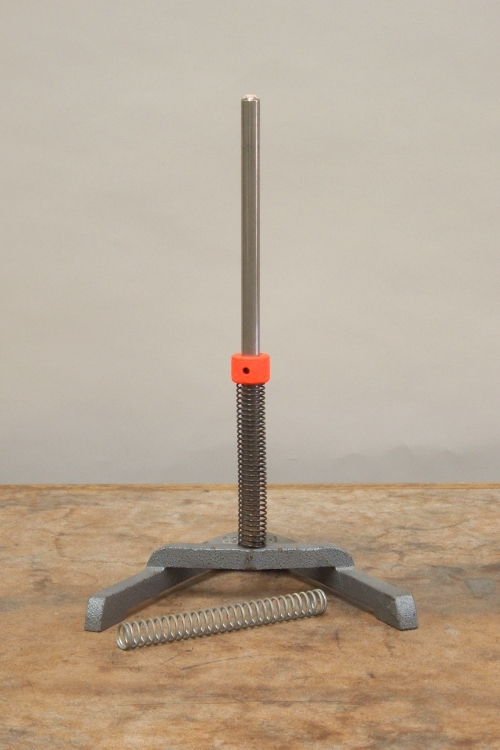
An orange metal sleeve slides over a rod to sit on a spring. When you slide it downward to compress the spring, and then release it, the sleeve flies into the air. The further you compress the spring, the higher the sleeve rises. The spring lying in front of the apparaus is stiffer than the one slipped over the rod. Both are provided so that if you wish, you can use both and compare their behavior.
When you compress a spring, the force you exert to do so is F = kx, where x is the distance by which you have compressed the spring relative to its original length, and k is the force constant of the spring. k is a measure of the stiffness of the spring, and its units are N/m. (The force the spring exerts in turn is F = -kx, which opposes the applied force to restore the spring to its original length. This is Hooke’s law.) The work you do in compressing the spring is W = ∫F · dx (= ∫kx dx). When we integrate, we find that W = (1/2)kx2. This is also the potential energy that is stored in the compressed spring.
When you release the sleeve, the spring now does work on it, equal to the potential energy that was stored in the spring. Once the spring is fully relaxed and the sleeve separates from it, the kinetic energy of the sleeve equals this work, or (1/2)mv2 = (1/2) kx2, where m is the mass of the sleeve and v is its upward velocity. As the sleeve flies into the air, gravity converts this kinetic energy back into potential energy, and the sleeve rises until mgh = (1/2)mv2, which of course also means that mgh = (1/2) kx2, where h is the distance from the top of the relaxed spring to the maximum height the sleeve reaches.
Thus, for a spring that has a given force constant, k, the height to which the sleeve rises, relative to the top of the relaxed spring, goes as the square of the distance through which you compress the spring. Also, the height to which the sleeve rises goes linearly with the force constant, or stiffness, of the spring.
References:
1) Resnick, Robert and Halliday, David. Physics, Part One, Third Edition (New York: John Wiley and Sons, 1977), pp. 121-122.